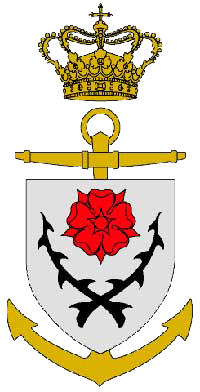



The model
I began building my model (scale 1:50) of the corvette FLORA in April 2017 and finished it in October 2019. It is my first "modern" warship (my previous models, which are of "historic" ships, can also be seen on this website) and many of the construction techniques were therefore new to me.
The model is 152.5 cms long, 19.5 cms wide and 50 cms. tall.
I have mainly used the original plans for the TRITON-class as source material as well as special drawings developed by the Royal Danish Naval Museum's Guild of Model Makers (of which I am a member), all kindly made available by the Guild. Furthermore, I have also used photos, around 300, many of which I took during the three years I served on FLORA (1963-66) and the rest consulted on various web sites.
Apart from the two propellers, anchor chains, sceptres, ship’s identification numbers, flags and a few other minor parts, I have made everything myself. This also ensures that it as authentic as possible and in the correct dimensions.
Some of the detailed working methods and materials used are described in the texts associated with the photo galleries.
Several kinds of wood have been used, e.g. balsa, pine and plywood. I have, for the first time, extensively used styrene on a model. It is an ideal material for many purposes, easy to work and provides a smooth surface on which painting can be applied directly. Plexiglass has been used in the making of portholes, searchlights and a few other details.
Brass has been used for all metal parts. For the more complicated structures requiring many soldering jobs, I have alternated between two soldering methods, one requiring 1000 degrees Celsius and another 400 degrees, thus it has been easier to avoid unsoldering already made joints.
I have also, for the first time, ventured into the art of photoetching, which has been used to produce doors, hand-wheels, hatches and various smaller parts. It is not that difficult but requires some practice in order to get the correct exposure and developing times.
Another “first” was making casts with polyurethane using silicon rubber moulds. This was used for life raft containers and lifebelts. A few decals were made for the life raft containers and coat-of-arms.
As shown in the photo galleries, many of the elements on the model have been made by mixing the use of wood, brass and styrene.
To all paint jobs I have used enamel paint. For some inexplicable reason I have never had confidence in water-based paint, which is probably not reasonable. Most paint is applied with an airbrush. The Royal Danish Naval Museum's Guild of Model Makers has been most helpful in suggestion the correct colours.
I have, as far as possible, tried to conform the look of the model to how FLORA looked when I was onboard. The things that changed most during the lifetime of the ship was the armament and the antenna systems. There is one major change from the model and the ship I sailed, namely the cover of the 76 mm guns, which in my time was a canvas cover drawn over a steel tube construction. On the model I have covered the guns with the more elegant light-alloy metal (styrene on the model) shields that were added only after 1966.
By the way, my own photos as well as other available contemporary sources (for example a film that was made on the sister ship TRITON while I was on FLORA) revealed several discrepancies from the original plans.
As the photo galleries show different stages in the construction processes, they are often self-explanatory with regard work methods and materials used.
Since, as mentioned earlier, I sailed FLORA from 1963 to 1966, constructing this model has also been a great trip down memory lane![]() .
.
Click: FLORA Video to view a short video (1 min. 9 sec.) af the finished model.